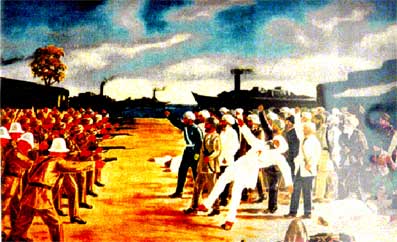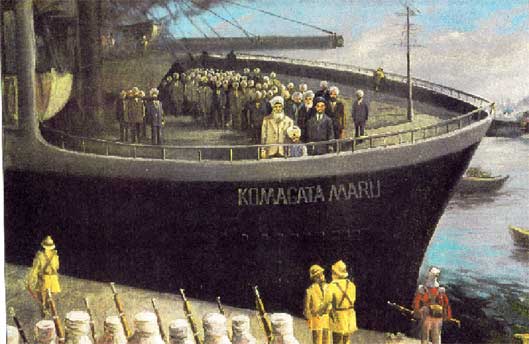
Baba Gurdit Singh with fellow passengers aboard the Komagata Maru
In the year 1900 the census reported 2050 people from India on the North American continent. The majority of these people were Punjabis who had settled in Canada. They had come with the hope of finding work so that they could improve their economic situation from what it had been in the Punjab. Upon arrival in Canada they encountered numerous hardships and discrimination. Canadians wanted the "brown invasion" to stop. They felt that the growing number of Indians would take over their jobs in factories, mills and lumberyards.
Route of Komagata Maru
It was these insecurities which led British Columbia to pass stringent laws discouraging the immigration of Indians to Canada. Indians had to have at least $200 on their person to enter British Columbia and had to have come via direct passage from India. These were very unreasonable laws as the average Indian only earned about ten cents a day. The Canadian government was also pressuring steamship companies to stop selling tickets to Indians. In 1907 a bill was passed denying all Indians the right to vote. They were prohibited to run for public office, serve on juries, and were not permitted to become accountants, lawyers or pharmacists. All this was done to stop the "brown Invasion." On the other hand Japanese and Chinese were immigrating in unlimited numbers. In 1914 the Komagata Maru was an outright challenge to these exclusionist laws. The Komagata Maru was a Japanese streamliner chartered by an affluent businessman, Gurdit Singh, to bring Indian immigrants to Canada. The ship's route departed from Hong Kong, stopped in Japan and then headed to Canada. Its passengers included 376 Indians, all Punjabis, among whom 340 were Sikhs, 12 Hindus, and 24 Muslims. The ship was eventually turned back at Vancouver where landing was refused, and terminated eventually at Calcutta.
"Bhai Gurdit Singh, Bhai Daljit Singh and his friend Bhai Vir Singh from Ferozepur were staying in the Sikh Temple of Hong Kong in 1914. The story of Chief Justice Hunter's judgement in Victoria, BC, about the release of 39 Asian Indians was on everybody's lips. The emigrants were overjoyed. Bhai Daljit Singh began selling tickets for departures to Canada. However, the British Government of Hong Kong was watching the activities of Bhai Gurdit Singh because the charter of Komagata Maru was in his name. Two days before the ship was to sail, Bhai Gurdit Singh was arrested by Hong Kong police on the charge of illegally selling tickets for an illegal voyage and the ship placed under police guard. The Sikh Police of Hong Kong were often used to terrorise prospective emigrants
Bhai Gurdit Singh was released on bail on March 24, 1914. Bhai Gurdit Singh knew Mr. Severn, chief secretary for the Governor of Hong Kong, while he was in Malaya. Mr. Severn told Singh that he had been waiting instructions from England and Canada, which never arrived. The governor granted Singh permission for passage on April 4, 1914. "That very day Komagata Maru left Hong Kong with 150 passengers. On April 8 at Shanghai, 111 emigrants boarded the ship, and on April 14, at the Port of Moji, 86, at the Yokohama port, 14 more passengers boarded the Komagata Maru totalling 376 passengers. From Moji, Bhai Gurdit Singh took 1500 tons of coal to sell in Canada and had intended to buy lumber from B.C. to sell back in the East. Finally, the Komagata Maru left Yokohama on May 3, 1914.
There were words of caution from several quarters to the passengers. Bhai Balwant Singh travelled in the Komagata Maru from Moji to Kobe and explained to the passengers the attitude of the British Government of India, Britain, and Canada towards their mission. Gyani Bhagwan Singh, who was forcibly deported from Canada on November 19, 1913, also the passengers at Yokohama and told them the story of his own deportation. Mahamad Barkatullah, the great teacher, who was professor of Hindustani in the University of Tokyo, also met the passengers of Maru in Yokohama. When Komagata Maru made it to Shanghai, a German cable company sent a message to the German press announcing the departure of the steamer Komagata Maru from Shanghai for Vancouver on April 14 with "400 Indians on board..." "The news was picked up by British press. The Vancouver daily "Province” published the inflammatory news report under the heading of "Boat Loads of Hindus on Way to Vancouver". The British Columbia press began giving such headlines to their articles as "Hindu Invasion of Canada".
The news of its departure reached the British Columbia authorities. Their instant reaction was that "Hindus would never be allowed to land in Canada." The Indians who had already settled in Canada had also started to prepare for the arrival of the Komagata Maru. Meetings were held in the Gurdwaras concerning what actions to take. Money and provisions were collected to help the passengers upon their arrival in Vancouver. The entire Indian community in Canada united to fight the opposition.
On May 23, 1914, the Komagata Maru reached Vancouver and anchored near Burrard Inlet. Both the Indians and the Canadian authorities had been waiting for it. The Canadians wanted to send the ship back to where it had originated. The Indians on the other side had lawyers, money and other provisions ready to help the passengers. The Canadian authorities did not let the passengers leave the boat claiming they had violated the exclusionist laws. The claim was that the ship had not arrived via direct passage and most passengers did not have the $200 that would have qualified them to enter British Columbia. For two months the passengers of the Komagata Maru, the Indians in British Columbia, and the authorities of British Columbia were involved in a heated legal battle. At the end of the two months only 24 passengers were given permission to legally stay in Canada. On July 23, 1914 the Komagata Maru was forced to leave Victoria harbor and return to Hong Kong.
The Return and the Budge-Budge Riot

The Komagata Maru approached Calcutta on September 26, 1914. As it approached Calcutta, a European gunboat signalled the ship to stop. The ship was put under guard and the passengers were held as prisoners. Then the Komagata Maru was taken to a place called Budge Budge, about seventeen miles away from its original destination of Calcutta. These new developments took the passengers of the ship by surprise. After two months of litigation in Canada they were not interested in any new developments of this kind. Upon inquiry by Baba Gurdit Singh as to the change of their course, an official informed him that the passengers were being sent to Punjab via a special train. Many of the passengers did not want to go to Punjab. They had business to attend to in Calcutta, some wished to look for work there, and most importantly, the passengers wanted to place the Guru Granth Sahib, which they had taken with them on their journey, in a Calcutta Gurdwara. The British officials did not care what the passengers wanted. They were going to be put on a train to Punjab and that would be the end of it. But the passengers were adamant on going to Calcutta. They were the rightful owners of the ship and the British officials had no reason to keep them on the ship or send them to Punjab. They felt that some action had to be taken, so they decided to march to Calcutta. Their main purpose on reaching Calcutta was to hand over the holy Guru Granth Sahib and to see the governor. The journey was long and after numerous threats by the police, they were left with no choice but to head back to Budge Budge. At Budge Budge, they were ordered to board the ship once again. The passengers, led by Baba Gurdit Singh, refused. A policeman attacked Baba Gurdit Singh with his baton but was stopped by a fellow passenger. It was at this point that firing started. Baba Gurdit Singh was carried to safety. But not all passengers were to be so fortunate. Twenty-nine fell victim to the bullets of British officials and 20 died. Here was another senseless massacre of innocent Indians at the hands of the British. That was the tragic end of the passengers of the Komagata Maru. The Komagata Maru returned to India's waters on September 26, 1914, leaving behind only twenty-four passengers who could prove residence in Canada. The repercussions of the Government's actions - the Budge Budge riot. The radicalisation of those abroad, the vigilante action against informers, the murder of Hopkinson, the execution of Mewa Singh, were overshadowed by the outbreak of World War I, in August 1914. Today the only reminders of this incident are a plaque near the Gateway to the Pacific in Vancouver, BC and a memorial plaque at Ross Street Gurdwara, in Vancouver, BC.
|
